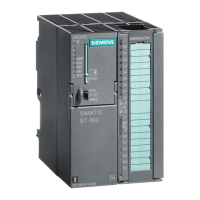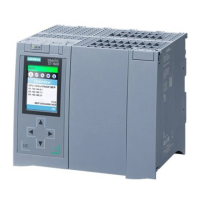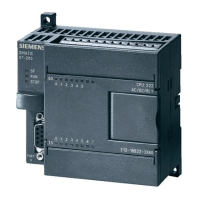&RPPLVVLRQLQJ
S7-300 Automation System, Hardware and Installation: CPU 312IFM - 318-2 DP
A5E00203919-01
9-25
6WDUWXSRI&38['3DV'3PDVWHU
During start-up, CPU 31x-2 DP compares the preset configuration of your DP
master system to the actual configuration.
If preset configuration = actual configuration, the CPU switches to RUN mode.
If the preset configuration
≠ to the actual configuration, the configuration of
parameter VWDUWXSLISUHVHWFRQILJXUDWLRQzDFWXDOFRQILJXUDWLRQ determines
the start-up behavior of the CPU.
VWDUWXSZLWKSUHVHWFRQILJXUDWLRQz
DFWXDOFRQILJXUDWLRQ \HV'HIDXOW
VHWWLQJ
VWDUWXSZLWKSUHVHWFRQILJXUDWLRQz
DFWXDOFRQILJXUDWLRQ QR
CPU 31x-2 DP switches to RUN mode.
(BUSF LED flashes if any of the DP slaves
cannot be addressed)
CPU 31x-2 DP remains in STOP mode.
When the 0RQLWRULQJWLPHIRUSDUDPHWHU
WUDQVIHUWRPRGXOHV runs out, the BUSF
LED starts flashing.
The flashing BUSF LED indicates that at
least one DP slave cannot be accessed. In
this case, check whether all DP slaves are
switched on or correspond with your
configuration, or read out the diagnostic
buffer with 67(3.
5HFRJQL]LQJWKHRSHUDWLQJVWDWHRI'3VODYHV(YHQWUHFRJQLWLRQ
The table below shows how CPU 31x-2 DP operating as a DP master recognizes
operating mode transitions of a CPU operating as a DP slave and data exchange
interruptions.
Table 9-8 Event recognition by CPUs 31x-2 DP acting as the DP master
(YHQW :KDWKDSSHQVLQWKH'3PDVWHU"
Bus failure interrupt
(short-circuit,
connector
unplugged)
• Call of OB86 with the message 6WDWLRQIDLOXUH
(coming event; diagnostic address of the DP slave assigned to
the DP master)
• with I/O access: Call of OB122
(I/O access error)
DP slave:
RUN → STOP
• Call of OB82 with the message 0RGXOHHUURU
(incoming event; diagnostic address of the DP slave assigned to
the DP master; Variable OB82_MDL_STOP=1)
DP slave:
STOP → RUN
• Call of OB82 with the message 0RGXOH2.
(outgoing event; diagnostic address of the DP-Slave assigned to
the DP master; Variable OB82_MDL_STOP=0)
7LS:
When commissioning the CPU as DP master, always program OB 82 and 86. This
helps you to recognize and evaluate data exchange errors or interruption.

